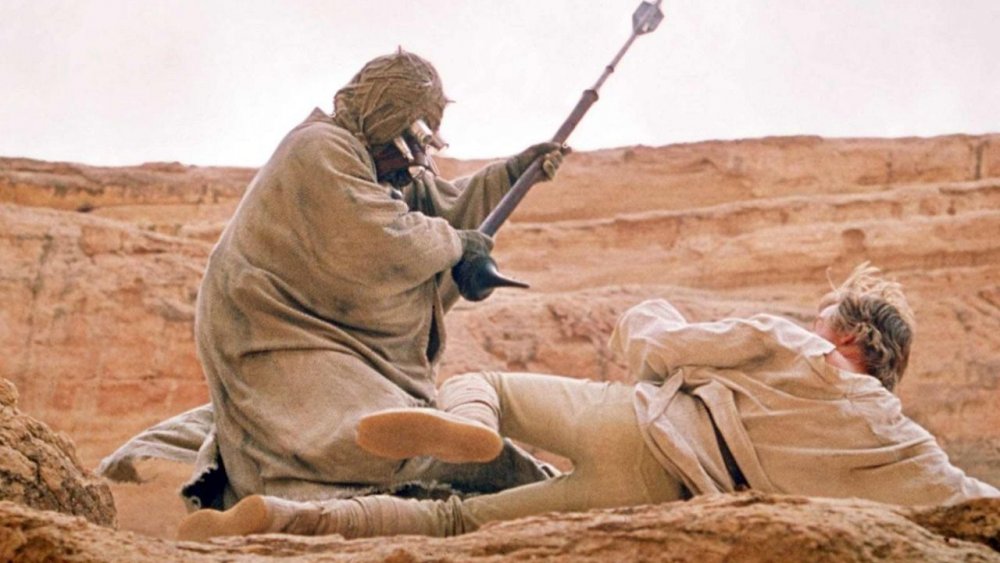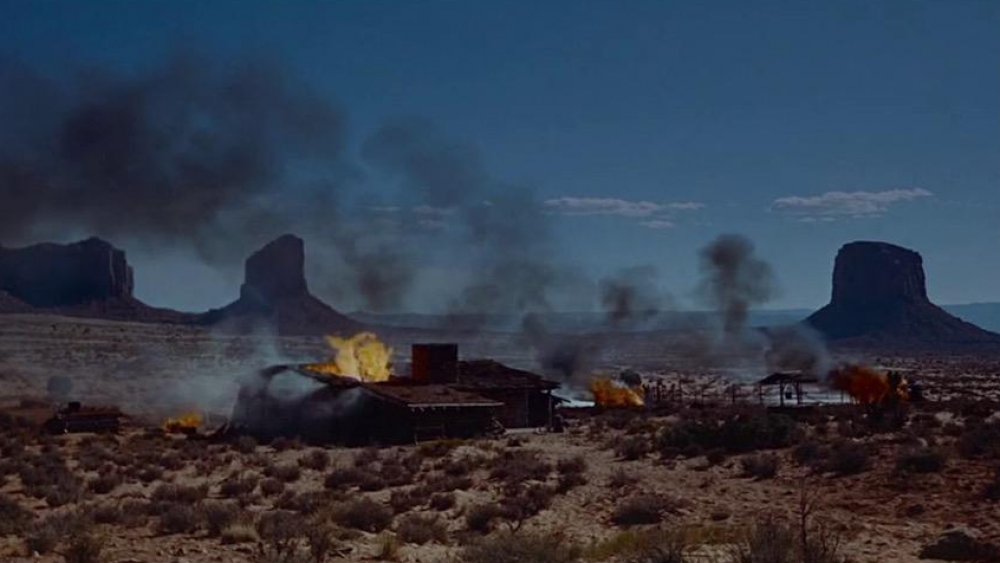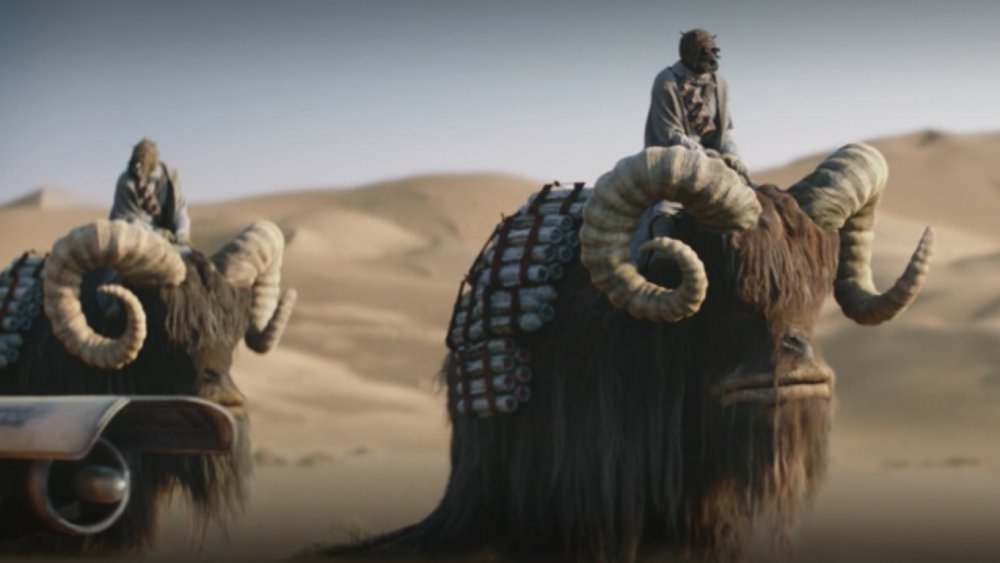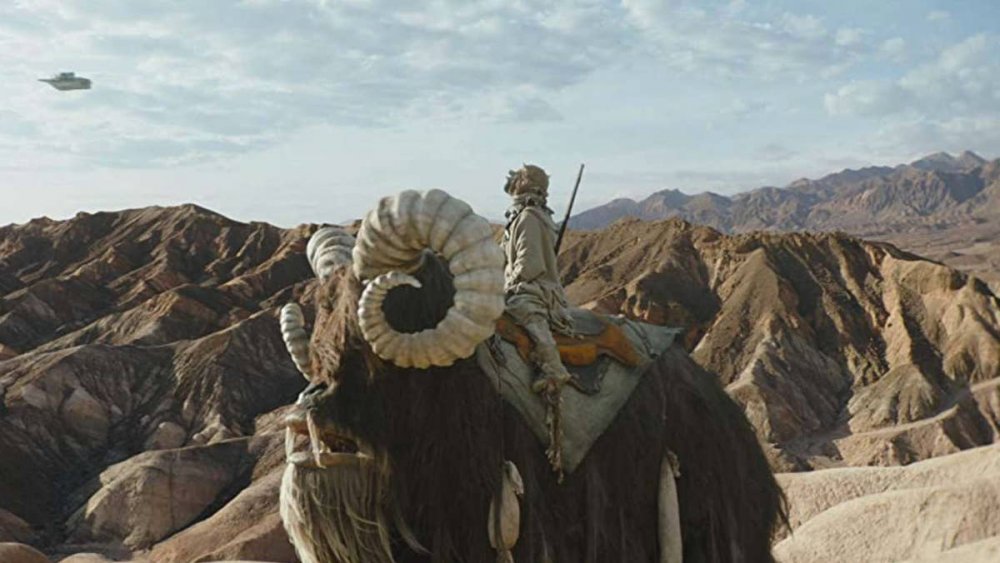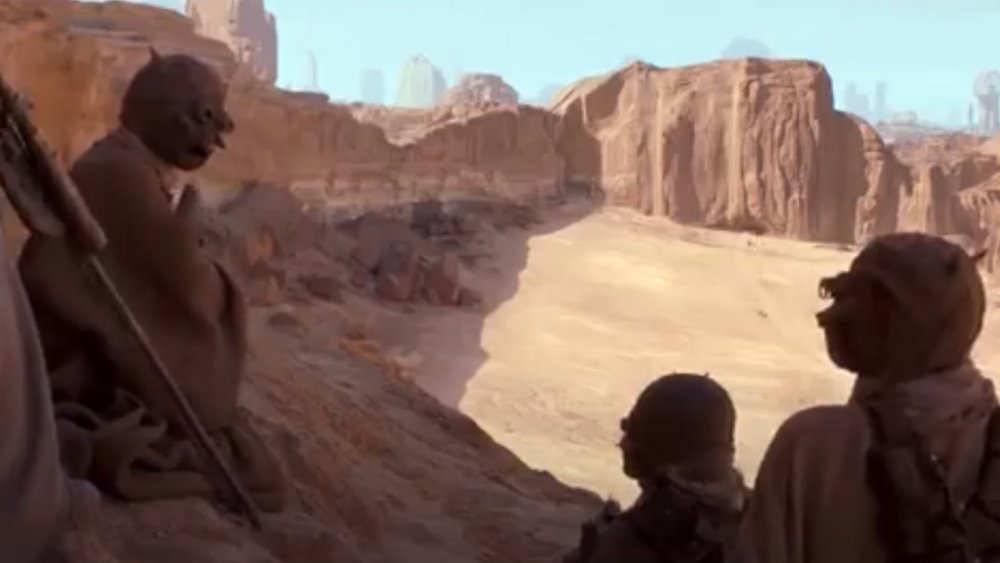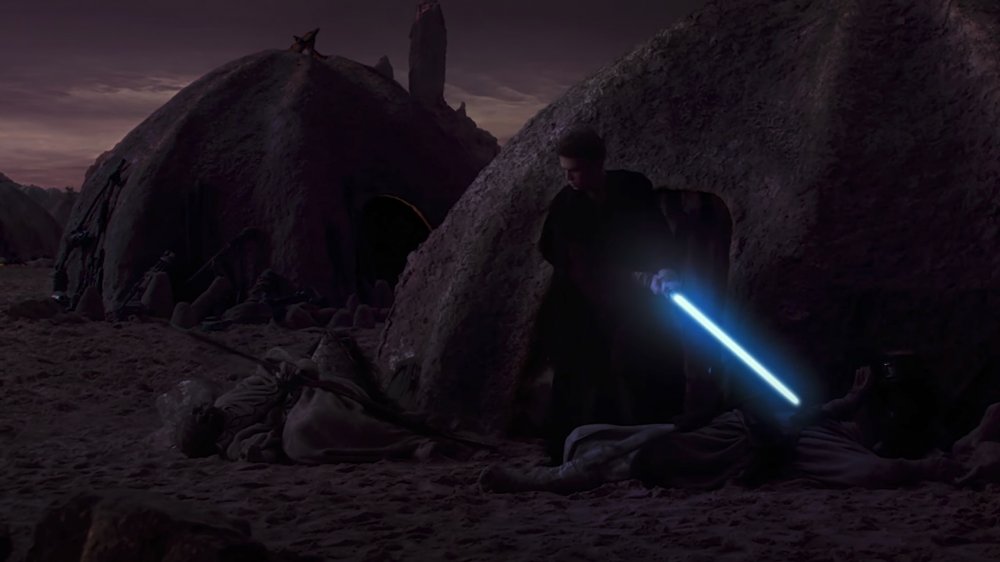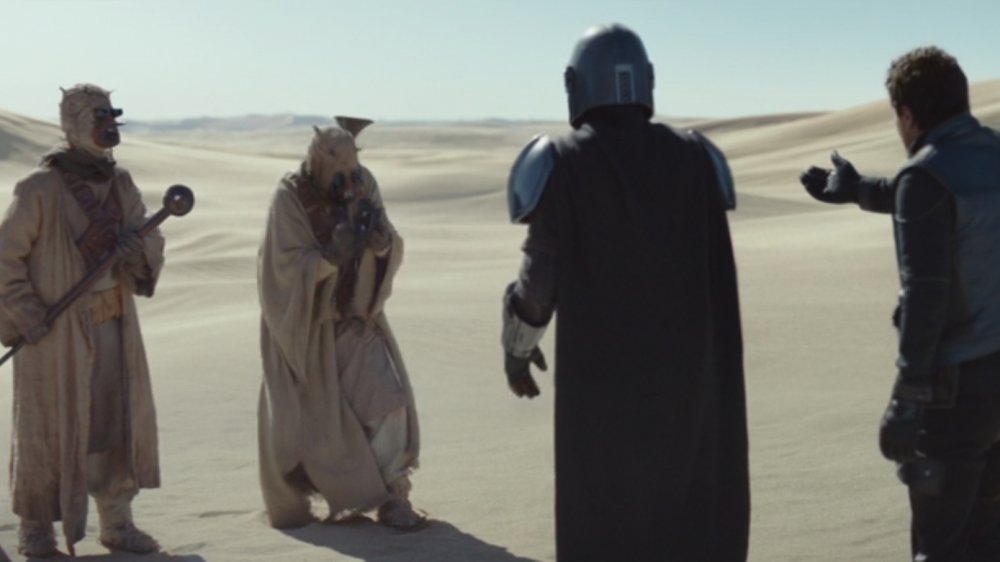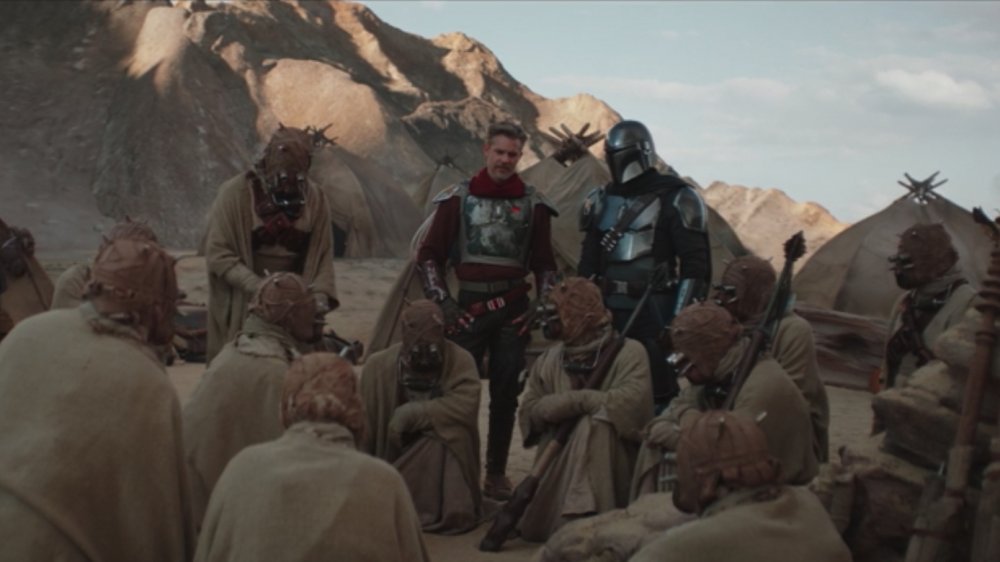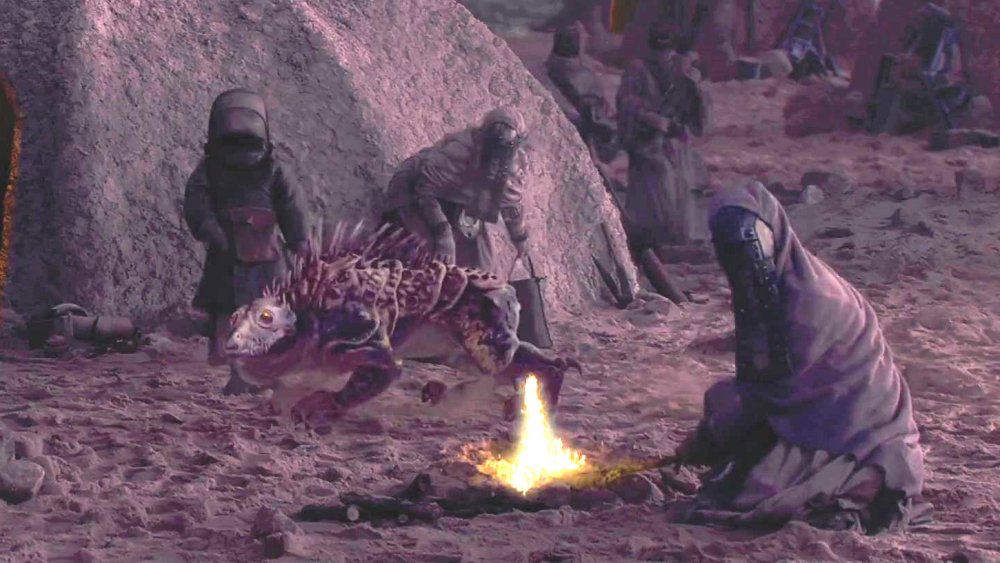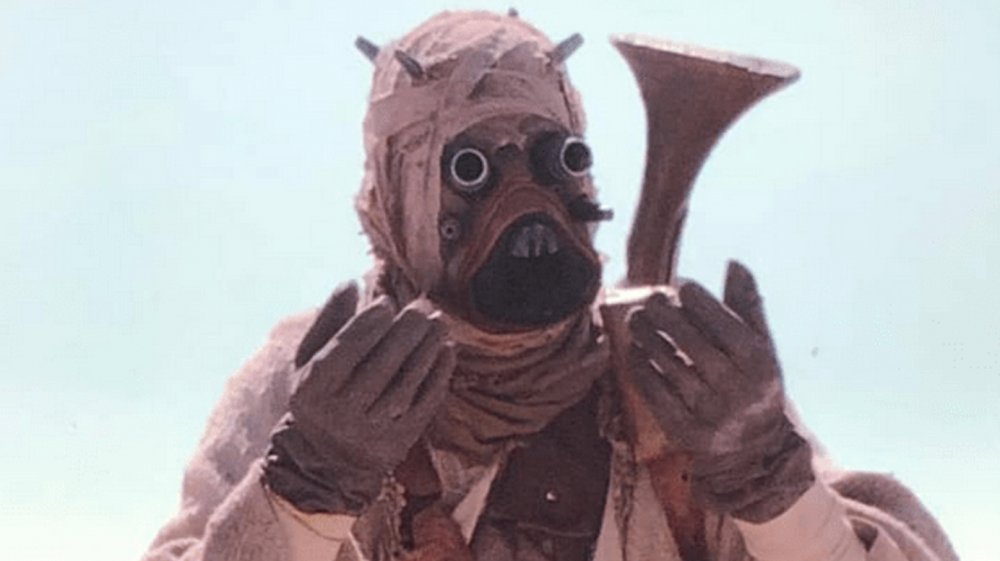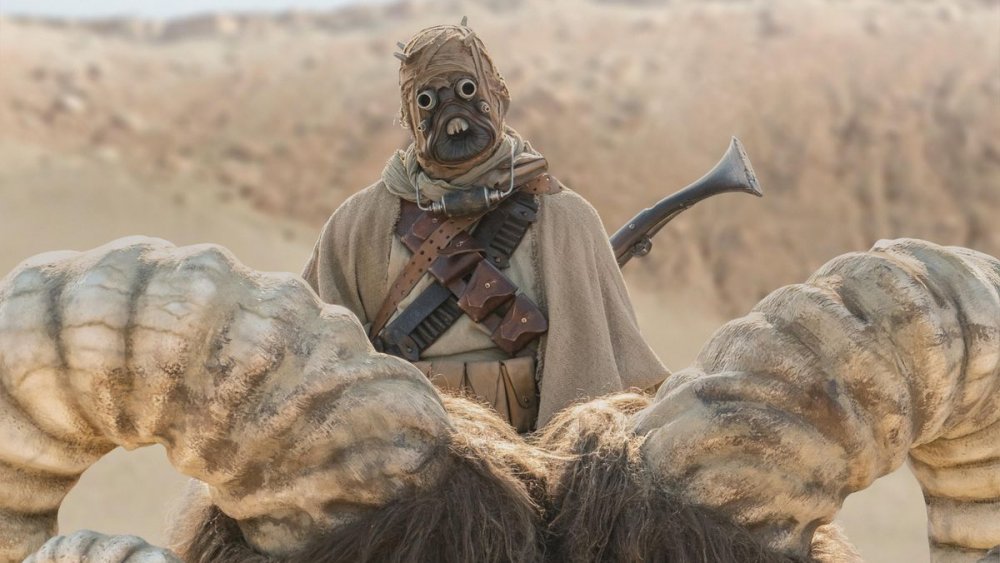The Tusken Raiders Of Star Wars Explained
Disney's The Mandalorian, which has jetpacked back into action with the premiere of its highly anticipated second season, continues to explore elements of the Star Wars mythology in ever more detail. While the fast-moving films introduce legions of creatures, locations, and characters, they are often only tantalizingly glimpsed in the background. Even the original Mandalorian himself, Boba Fett, was only briefly introduced in the original trilogy. But as the Star Wars universe continues to unfurl, many hours of new film and television content richly explore the nooks and crannies of the galaxy far, far away.
The Tusken Raiders are among those briefly glimpsed characters being further explored. Also known as the "Sand People," the Raiders are a desert nomad people indigenous to Tatooine, the first planet introduced in the Star Wars universe and one the saga returns to regularly. While the Sand People haven't played a central role, they have made multiple appearances, not only in movies and shows, but in many video games, comic books, and novels. And while their presence has been typically limited, they have affected the fates of several major characters, including Luke and Anakin Skywalker in the original and prequel trilogies, and now the Mandalorian and the Child. But even though Tusken Raiders show up in Star Wars from the very beginning and reappear throughout, they remain mysterious and poorly understood. Who are they? Where do they come from? What do they want? And what do fans and casual viewers alike need to know about them?
By attacking Luke Skywalker, they almost ended Star Wars before it started
The Tusken Raiders appear first and most memorably in A New Hope. The Sand People are initially presented as fearsome savages, dangers to "civilized" people like Luke Skywalker and his family. They roam the desert, attacking and pillaging the unsuspecting. When Luke leaves the safety of his homestead to search the Jundland Wastes for his escaped droid, R2-D2, the Raiders quickly overpower the naive and unprepared young man, knocking him unconscious so they can ransack his land speeder. Luke is only saved when the mad hermit Ben Kenobi appears and scares away the Raiders by mimicking the call of the Krayt Dragon, a beast they fear. Kenobi explains that his trick works essentially because the Sand People are simplistic — "They are easily startled," he says — another nod to their animalistic natures.
Of course if Luke had died in this scene, he never would have blown up the Death Star, fought Darth Vader, become a Jedi Knight, or brought balance to the Force. Perhaps the trilogy would have centered on Leia Organa, Luke's Force-sensitive sister, instead.
George Lucas intended for them to resemble Bedouins
Star Wars mastermind George Lucas created the Tusken Raiders and their desert world to resemble the Bedouins, tribes of Arab nomads who have roamed the deserts of North Africa, the Arabian Peninsula, and the Middle East for thousands of years. The Bedouins are herders and raiders who historically attacked and pillaged villages and caravans, much as the Sand People do in Star Wars.
However, it's likely Lucas' conception of the Raiders was also influenced by the "savage Indians" of John Ford Westerns, especially from The Searchers, which Star Wars famously pays homage to. In The Searchers, Comanche attack the white settlers' homestead, killing the family and burning the house down. While it's the Imperial stormtroopers, and not the Tusken Raiders, that exterminate Luke's family, Lucas designed the scene in direct homage to the scene from The Searchers. In general, Lucas depicts the Sand People the way that Ford depicts the Comanche: brutal, bloodthirsty and uncivilized. Given Lucas' famous tin ear for racial stereotypes (most prominently on display in The Phantom Menace), it seems likely that he (perhaps unconsciously) equated the Tusken Raiders with the stereotype of the "savage" Indian.
Other possible influences: "Tusken" has phonetic resonance with "Tuskegee," as in the Tuskegee Airmen, the first Black U.S. Army airmen who trained at the Tuskegee Army Air Field in Alabama before flying in combat during World War II. Lucas has long been interested in their story, even making a movie about them with 2012's Red Tails. Finally, Lucas was influenced by Frank Herbert's sci-fi novel Dune, which features nomad dwellers on the desert planet Arrakis.
They have their own form of animal transportation - the Bantha
Banthas are large, trundling creatures that resemble elephants with huge, droopy faces. They have curving tusks on the sides of their heads shaped like cornucopias, or perhaps Princess Leia's hair buns in A New Hope. The Raiders use them as beasts of burden. Lucas clearly liked the Banthas, as he digitally inserted a lot more of them in the special edition of Return of the Jedi, which features a herd of "wild" Banthas roaming the Tatooine desert. They are seen as Jabba the Hutt transports Luke, Han Solo, and company across the Dune Sea to the Pit of Carkoon to be slowly digested over a thousand years by the mighty Sarlacc. This is an appropriate fate, since Jabba has just told Han, "You may have been a good smuggler, but now you're bantha fodder." Digital banthas also appear briefly in The Phantom Menace and Attack of the Clones.
Chapter 9 of The Mandalorian heavily features Banthas. Early in the episode, the Krayt Dragon — a huge worm-like creature — swallows one whole. Later, a Tusken Raider brushes a Bantha's teeth (Bantha-vitis is evidently a thing). In the (spoiler) climactic scene, a Bantha is rigged with explosives and used to bait the Krayt. The dragon swallows the Bantha bomb and the Mandalorian detonates it, causing both animals to explode in a shower of flame and flesh. In other news, the ASPCA does not appear to have a Tatooine chapter.
The Bantha bond
While it's true that Banthas provide the Tusken Raiders with a means of transportation across Tatooine's unforgiving terrain, they aren't merely beasts of burden. In fact, every Tusken has a deep lifelong connection with their Bantha — the culture's initiation rite, which typically takes place during youth, includes gifting the initiate a Bantha that matches his or her gender. When Tuskens marry, their Banthas mate as well — and in the unfortunate circumstance that a Bantha should die before its rider, tradition calls for its remains to be interred in a graveyard with sacred meaning to the Tusken people.
One of the Star Wars saga's strongest points is the way in which even incidental elements can be fully fleshed out into stories of their own, and the bond between the Banthas and the Sand People is a perfect example. They may have served as little more than a brief, terrifying plot point in A New Hope, but the hidden depths to their story offer some of the franchise's most compelling allegories.
They have their first callback in Episode I: The Phantom Menace
The Tuskens have a cameo during the Episode I podracing sequence and their brief appearance in the movie echoes their aggressive characterization from A New Hope. In the scene, young Anakin Skywalker is racing the villainous Sebulba to gain his freedom from slavery when the Tuskens attempt to disrupt the race. From their perch in the rocky hills above the desert race track (having the "high ground" is always very important in the Star Wars universe), the Raiders take pot shots at the racers with their long-barreled rifles, and celebrate when they hit Anakin's pod. Whether the Tuskens are doing this for vicious sport or whether they feel they are protecting their territory from interlopers is never specified. Either way, the brief scene sets the stage for the Tuskens' longer appearance in Episode II, a movie that seems to use their established villainy to justify their wholesale slaughter.
Interestingly, Terry Brooks' novelization of The Phantom Menace complicates the savage characterization of the Sand People by inventing a new scene in which Anakin helps a wounded Raider he discovers in the desert. Although Anakin finds him "chilling," writes Brooks, he can also "sense the pain in the other's gaze" and "feel the desperation." This is one of the earliest attempts in Star Wars to portray the Sand People with empathy, as something other than savages. The Mandalorian takes this empathetic characterization even further.
In Attack of the Clones, they push Anakin further toward the Dark Side
Tusken Raiders feature prominently in Episode II: Attack of the Clones, in which they kidnap and brutalize Anakin's mother, Shmi Skywalker. Anakin sneaks into their camp to retrieve her, but he is too late and she dies in his arms. In a fit of vengeful rage, he exterminates every Raider in the camp, including women and children.
This scene appears to further equate the Sand People with Native American cinematic "savages" in Lucas' vision. The kidnapping and slaughter in Attack of the Clones again echoes The Searchers, when John Wayne's character, Ethan, discovers kidnapped white women in Comanche tents similar to the ones in Episode II. Later, Ethan gleefully participates in a bloody slaughter of the Comanche, which includes scalping them. Anakin also appears to relish his butchery. He tells Padme, "They're like animals, and I slaughtered them like animals. I hate them!"
Although Lucas means to portray Anakin's killing as heartless — a significant step toward his embrace of the Dark Side — the director's sympathies seem to lie at least partially with Anakin. Anakin may be in the wrong, but the Raiders are nevertheless depicted as sub-creatures, undeserving of pity. However, if we treat the Terry Brooks novelization of The Phantom Menace as canon — and it seems as though Star Wars still does — Anakin's actions are much worse, given his previous empathetic and peaceful interaction with the Sand People.
The Mandalorian Chapter 5 humanizes the Tusken Raiders
Like most pop culture properties that have been around for decades, Star Wars has tried to keep up with the times by reflecting social and cultural changes. In particular, the franchise has attempted to be more diverse in its race and gender representation, an effort that has resulted in backlash from some fans who don't care for change. The Mandalorian has been part of this effort, both with its casting and behind the camera. It even attempts a makeover of the Tusken Raiders by representing them as a less overtly aggressive and more complex culture.
The more complex portrait of the Sand People of The Mandalorian debuts in Chapter 5 of season 1. When a character says of them, "I heard the locals talking about this filth," the Mandalorian responds, "Tuskens think they're the locals. Everyone else is just trespassing." He then peacefully attains passage through their land by negotiating with them in their sign language. This is the first notion anywhere in filmed Star Wars that Raiders have a language, let alone one that allows them to communicate with other peoples. Language is one of the most important markers of civilization and this episode presents it as a feature of the Tuskens, who are no longer depicted as the backwards savages of previous eras.
Chapter 9 of The Mandalorian develops their culture even further
After their cameo in Chapter 5 of season 1, the Tuskens return in the action-packed season 2 opener in an even more vital role. In this episode, the Mandalorian enlists their help to kill a Krayt Dragon. This quest returns full circle to the saga's introduction of the Sand People in A New Hope, when Ben Kenobi's Krayt noises frighten them away from Luke. But this time we see the actual beast, and quickly understand why the Sand People, as well as the human settlers of the frontier town Mos Pelgo, fear it.
Consistent with the mistrust dramatized between settlers and natives in so many Westerns, the human settlers in Mos Pelgo are reluctant to trust the Sand People until the Mandalorian (here taking on the role of the "man with no name") brokers a tentative peace. Naturally, the Mandalorian is fluent in two separate dialects of Tusken — one silent, one spoken — and so is able to explain that the nomads are not only capable and rational, but also honorable people who keep their word. Working together, the humans and Tuskens defeat their common enemy. Of course many of the Sand People die in the cause, while virtually all the humans walk away unscathed. Tusken Raiders may have come a long way in the Star Wars universe, but evidently they are still expendable.
More about Tusken culture
Not much about Tusken culture is seen or discussed in the Star Wars movies, but as with just about any other species that's even so much as glimpsed in the background of a scene, there's a deep well of information about the Raiders that Star Wars fans can glean from a variety of sources. Indigenous to Tatooine, the Tusken Raiders not only view outsiders with deep and often violent mistrust, but they regard natural resources — particularly water — with a spiritual level of respect. It's this component of the Tusken belief system that led them to raid moisture farms and attack travelers who wandered too close to the planet's scarce natural wells.
Of course, all any longtime Star Wars fan wants to know about the Tusken Raiders is what they look like under their masks — a question that seems unlikely to ever be answered in canonical media. The Tuskens have an almost religious aversion to removing them, only showing their faces during life milestones such as their wedding night. (Yep, Sand People get married too.)
The story behind Tusken sign language
The Tusken Raiders speak using a combination of vocal speech and sign language — and as we see in The Mandalorian, our hero is well-versed in both forms. What casual viewers may not realize, however, is that Tusken sign language is real — and it was developed by actor Troy Kotsur, a Mandalorian actor who is deaf.
"I did research on the culture and environment of Tusken Raiders," Kotsur told The Daily Moth in a January 2020 interview. "My goal was to avoid ASL [American Sign Language]. I made sure it became Tusken Sign Language based on their culture and environment."
Mandalorian viewers caught a good glimpse of Kotsur's work during the season 2 episode "The Marshal," in which Mando and Cobb Vanth team up with a Tusken tribe to kill a Krayt Dragon that's been plaguing the Tatooine outpost of Mos Pelgo — and for those who'd like to see more, he has a simple message. "I hope that you keep telling Disney+ that you want to see more sign language," he added. "I hope that the producers keep an open mind, because this is just the beginning."
They were one of the original 12 Kenner Star Wars action figures
In 1977-'78, the first year after the original film's release, Star Wars sold $100 million worth of toys. Since then, Star Wars toy merchandising has become a billion-dollar industry, still thriving today with new action figures, Funko Pops, and Lego sets (among many others) introduced regularly. There are even books and documentaries devoted to the creation and selling of the toys, as well as many volumes and sites cataloging them. George Lucas famously negotiated the rights to the Star Wars sequels from 20th Century Fox partially so he could have the merchandising rights as well. One cynical way of explaining the sheer number of new characters and ships for each new movie is by considering how many new toys Lucas could peddle.
Along with their more diminutive fellow Tatooine dwellers the Jawas, the "Sand People" — as they are referred to on their action figure card (a little weird, since there is only one inside the package — maybe it should be termed just "sand person?") — were among the first dozen figures to kick off the global merchandising phenomenon. There have been many iterations of the figure since, some now going by their proper Tusken Raider designation. The original vintage action figure, now a collector's item, can be had for the low, low price of just $800 on Ebay.

